Main Body
6 Public health and the law
Hector (Giovanni) Antunez
Learning Objectives
By the end of this chapter, the learner will be able to
-
Learn about the role of the law, government, and public health
- Learn about the major types of the law and which one applies directly to public health
- Identify the role of the federal government in public health as the leading organization for public health activities
- Describe the different applications of the role of law in public health
- Apply the concepts learned about public health and the law in the work of maintaining a healthy nation
Public Health and the Law in the United States
Public Health and the US Constitution
As it is said in chapter 1 of this book, the U.S. Constitution does not mention the word ‘public health,’ it only mentions a duty to “promote the general welfare,” of its people without more specifics. Is this bad for public health? Let’s see what the answer to this question takes us [1]
 |
| Image “We the People,” from Flickr, CC BY, NC, SA 2.0 |
 |
| Image “The Tenth Amendment,” by Nick Youngson, from Pix4free, Licensed CC BY-SA 3.0 |
From a superficial view there is a contradiction here, one amendment ‘gives states all powers,’ and another ‘limits that power,’ but according to experts in constitutional law, what the Fourteenth Amendment does is to emphasize the limits of those stowed power, so, the states don’t fall into abuses. [3] One example of this is the exercise of the police power of public health during the COVID 19 pandemic in which a great number of people in the U.S. had difficulties with the public health mandates to get vaccinated against COVID, a lot of people felt that the ‘federal government represented by the public health system,’ does not need to tell people what to do, or, what not to do. People have struggled with this until now, and many individuals who rejected the vaccines have also lost their lives to the COVID-19 virus. [4]. This seems to be a new thing, but this has happened also in the past in this country, an example is the case Jacobson v. Massachusetts (1905 Court Case) about the Legality of Vaccine Mandates. Two things happened in this case, the justices held that the mandate also did not violate the 14th Amendment because it was the government’s duty to protect public health, and because the mandate applied to all adults equally, it did not violate the Equal Protection clause. If similar demands are submitted during this time of pandemic, the court may use this case as a reference. [5]
The role of law in public health
In addition to the articles of the U.S. Constitution that are related to public health, there is a need to mention here also, what are the different forms of law, and how they are used in what is known as public health law. The purposes of public health laws are to protect and promote health (police and general welfare powers) and ensure the rights of individuals.[6]
In this context, the different forms of law are: 1) Constitutionally based law, 2) Legislatively based law, 3) Administrative law, and 4) Judicially based law.[7], [8] These concepts are briefly outlined in the following paragraphs.
Constitutionally based law
It is derived from the U.S. Constitution which outlines the powers, duties, and limits of the federal government. Additionally, it includes a Bill of Rights that protects individuals from potential government abuse. Certain powers, such as national security, defense, foreign policy, and printing money, were given up by states to the federal government. However, health is not explicitly included in these powers. Each state has its constitution and is responsible for making decisions on what is important for its citizens through statutes.
Legislatively based Law
Statutory law, also known as Legislative-based law, is a legal system used by states to determine which healthcare activities are important for them. For instance, the use of public health nurses, authorizations given to restaurants, and prohibiting smoking in public places. As mentioned in other portions of the textbook about statutory or legislative law, if the intent is for something to occur, the most effective approach is to require or prohibit an activity.
Judicially based Law
This type of law is also known as common law. Common law is a term used to describe a collection of legal customs, traditions, and previous court decisions at both the federal and state levels. It becomes particularly important in areas where legislators have not created laws. For instance, judiciary law may be used to address public health nuisances like unsanitary conditions or similar issues affecting a specific community. The precedent for common law in such cases is typically derived from previous judicial decisions.
Administrative Law
Although states create statutes under legislative-based law, the execution of these statutes with their respective recommendations is the responsibility of state agencies such as local public health departments. Rather than creating complicated structures to implement these statutes. Administrative agencies are provided with the authority to establish law through rule-making processes.
At this point
Let’s stop here to recall that we have discussed the four major types of law (constitutional, legislative, administrative, and judicial) to better understand the purposes of public health law. See an image on how the different types of law interact:
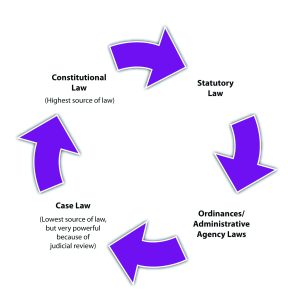 |
| “Diagram and Hierarchy of the Sources of Law”, image from University of Minnesota Open Libraries, no licensed stated. |
Public Health Law
What are the purposes of public health law?
As it is seen, the application of public health laws is not an easy task. There have been many critiques of the statutory basis of public health in the U.S., and one major critique is that public health laws have not kept pace with the advances in science and technology. Also, some public health laws have been enacted without taking into consideration previous statutes – lack of consistency. Given some of the mentioned criticisms, recommendations have been given by several panels and working groups that mainly focus on the following: To match public health statutes and ordinances with the overall mission and core functions of public health (assessment, policy development, and assurance). To keep uniform structures for similar programs (e.g. For Sexually Transmitted Infectious diseases), and services (e.g. vaccinations for HPV).
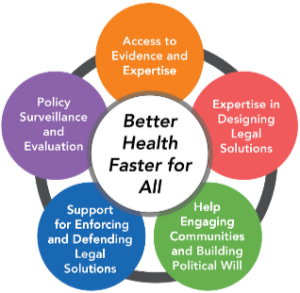 |
| “The Five Essential Public Health Law”, image from the Network of Public Health Law, no license stated. |
Recapitulating
As discussed above, the intricacies of public health work demand more attention to the administrative processes, assuring that fairer and more consistent practices are put in place. These comments take us back to the topic of administrative-based law used in public health.
Administrative law
Under this type of law, there is a major concept, and it is that the ‘separation of powers (legislative, executive, judicial) is not apparent’ in administrative law. Another feature is the importance of ‘Reliance on experts and professionals. An overall feature is that administrative law has an extensive impact on daily life. And, what about the organization of the public health system? Since administrative law is concerned with how “Congress can effectively delegate its legislative power to an Administrative agency,”[9] In this case, the ‘administrative agency’ is the public health system, which is organized at different levels: [10]
- National: federal health agencies such as the Department of Health and Human Services (DHHS) and its components
- Tribal: Indian Health Service and others
- State: state health agencies such as health departments and human service agencies
- Local: local public health agencies, often called local health departments
The following organizational chart shows how the public health system is organized in the United States:
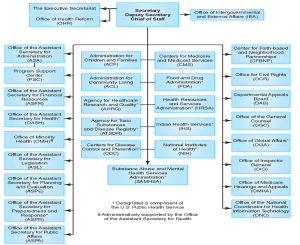 |
| Image from “Department of Health and Human Services (DHHS), Organizational Chart, 2014”, from DHHS, Public Domain. |
In the figure above, the major administrative programs at the national level are presented.
The budget of the above-mentioned agencies and related public health programs comes from the national health expenditure, which is currently 17.3% of the Gross Domestic Product (GDP). See image below presenting these data.
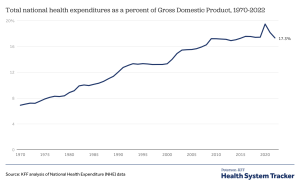 |
|
“Total national health expenditures as a percent of Gross Domestic Product, 1970-2022,” image from Peterson KFF Health System Tracker, Health System Tracker. |
When compared to other countries, particularly low and middle-income nations, a National Health Expenditure of 17.3% may seem like a large amount. However, it is not, considering the numerous requirements for public health programs. Additional funding is necessary for the development of an effective healthcare system.
In addition, it is also helpful to see the national health expenditure in terms of per capita income, how much is allocated for each U.S. person in the total population. See image below:
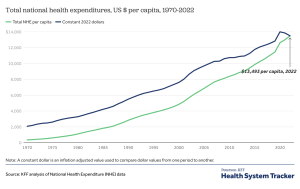 |
| “National Health Expenditures Per Capita”, image from Peterson KFF Health System Tracker, Health System Tracker. |
Continuing with a review of the national health expenditures, it is important to know how much is expended by federal and state public health agencies, and related services. A graph of the distribution of national health expenditures is presented below:
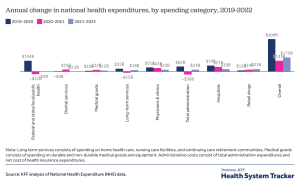 |
| “Annual change in national health expenditures, by spending category, 2019-2022,” image from Peterson KFF Health System Tracker, Health System Tracker. |
Continuing with the organization of the system, the following graph displays how much in terms of budget is allotted to what is known as, the major Public Health Services (PHS) agencies that are under the Secretary of Human Services. These agencies provide among other services, guidance in terms of how to plan and implement public health programs, research grants, and program implementation, or any other needed public health intervention.
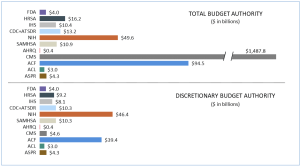 “FY2024 President’s Request for HHS by Operating Division,” image from Department of Health and Human Services: FY2024 Budget Request June 29, 2023, page 8. “FY2024 President’s Request for HHS by Operating Division,” image from Department of Health and Human Services: FY2024 Budget Request June 29, 2023, page 8. |
The role of the American federal Government and Public Health
Before continuing with the review of administrative agencies, it is essential to consider the following facts: In the United States, it is often said that "all politics is local." [11] However, when it comes to public health, the same principle applies. Public health action occurs at the community level or locally, and because of its locality, public health is inherently political. In other words, “all health is local.”
In addition to concept of all health is local, it is important to note that there is a connection between Federalism and Public Health. In the United States, public health policy and programs are significantly influenced by fiscal and functional federalism. What does this mean? It means that federalism affects the practice of public health, and this includes how funding is allocated based on program goals and priorities that are made in a political context. Without politics, no funding is allocated to the U.S. public health system. [12] Adding to the issues discussed above, it is also important to understand that the roles of national, state, and local governments in health are relative, and these roles can shift over time depending on the changes in social values in American society.
After clarifying the aforementioned principles, the organization of public health agencies will be discussed in the upcoming content of this book.
Selected Characteristics of Local Health Departments (LHDs)
It has been said that the local health, departments are “Where the rubber meets the road”, although funding and direction are received from state and federal agencies. There are two basic arrangements for local health departments: decentralized and centralized. The Decentralized arrangement relates primarily to local government although may also report to a state health agency, and the Centralized refers to a unit of the state health agency.
In addition, the size of the public health agency defines its category, which depends on the number of the population served, so, a public health agency can be small, medium or, large. The following image below presents this information:
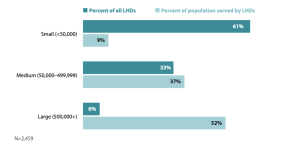 |
| “Percent of United States population served by LHDs,” Image from NACCHO 2019 National Profile of Local Health Departments, Chapter 2 Jurisdiction and Governance.[13] |
As a continuation, let’s see what are the major services (in terms of programs) that are provided by LHDs.
Programs and Services
The following image represents the services that rural LHDs are more likely to provide than urban LHDs. Overall, LHDs serving rural jurisdictions are more likely to provide certain clinical services, including childhood and adult immunizations, maternal and child health services, and screening/treatment for various conditions.
 |
|
“Programs and services that rural LHDs are more likely to provide than urban LHDs,” image from from NACCHO 2019 National Profile of Local Health Departments, Chapter 7 Program and Services.[14]
|
Now a continuation of the programs and services that are more likely to be provided by Urban LHDs than Rural LDHs. Overall, LHDs serving urban jurisdictions are more likely to provide regulation, inspection, and licensing services, as well as environmental health services.
 |
| “Programs and services that are more likely to be provided by Urban LHDs than Rural LDHs,” image from from NACCHO 2019 National Profile of Local Health Departments, Chapter 7 Program and Services.[15] |
Total annual LHDs expenditures, how much Local Health Departments are spending? As the image below shows, in the year of 2019, the total annual LHDs expenditures range from less than $250,000 to $25 million or more.
 |
| “Total annual expenditures,” Image from NACCHO 2019 National Profile of Local Health Departments, Chapter 6 Financee.[16] |
Local Health Boards
In the U.S. the law also dictates the institution or, formation of Local Health Boards that support and advise the local health departments. The National Association for Local Boards of Health (NALBOH) identifies six functions of public health governance. This information is presented below in the image that follows:
 |
| “Functions that local boards of health (LBOHs) utilize on a continuous basis,” Image from NACCHO 2019 National Profile of Local Health Departments, Chapter 2 Jurisdiction and Governance.[17] |
Assessment Planning and Accreditation of Local Health Departments (LHDs)
The image below shows LHDs participation in a community health assessment (CHA), community health improvement plan (CHIP), and/or strategic plan (SP) within five years, by the size of the population served.
 |
| “LHDs participation in assessment, planning and accreditation,” Image from NACCHO 2019 National Profile of Local Health Departments, Chapter 9 Assessment, Planning, and Accreditation.[18] Note: Large LHDs were the most likely to complete a CHA, CHIP, and SP, while small LHDs were the least likely. |
Finally in this chapter, what are the forces shaping governmental public health? The answer is, public health should be shaped by the science and social values needed to make public health stronger, and more evidence-based. There are several expectations including how the federal role in public health could be diminished giving more opportunities for the development of more health policies that are needed but that are not implemented because of political disagreement at the federal level. Overall, the intention is to work ahead in a public health system that adequately responds to the needs of this Twenty first century.
- Whitney Jr., W. T. (June 16, 2022). The U.S. Constitution: Bad for public health? People's World, from https://peoplesworld.org/article/the-u-s-constitution-bad-for-public-health/ ↵
- Temme, Esq., L. (July 29, 2022). How the Fourteenth Amendment Limits Government Policing Powers. FindLaw, from https://constitution.findlaw.com/amendment14/annotation07.html ↵
- Smentkowski, B. P. (Jan 12, 2024). Tenth Amendment. Encyclopedia Britannica. https://www.britannica.com/topic/Tenth-Amendment ↵
- Temme, Esq., L. (July 29, 2022). How the Fourteenth Amendment Limits Government Policing Powers, does public health violates the constitution? FindLaw, from https://constitution.findlaw.com/amendment14/annotation07.html ↵
- Ravid, A. (Aug. 12, 2021). Jacobson v. Massachusetts: How a 1905 Court Case May Determine the Legality of Vaccine Mandates. FindLaw [blog], from https://www.findlaw.com/legalblogs/courtside/jacobson-v-massachusetts-how-a-1905-court-case-may-determine-the/ ↵
- Holt, JD., Navalkar, G., Black, JR. (n.d.). Legal Considerations. The CDC Field Epidemiology Manual. From https://www.cdc.gov/eis/field-epi-manual/chapters/Legal.html ↵
- No author. (n.d.). Types of Law and Jurisdiction. American Women: Resources from the Law Library at the Library of Congress Research Guides. From https://guides.loc.gov/american-women-law/types-of-law ↵
- No author. (n.d.). 1.6 Sources of Law, In Criminal Law, a textbook adapted edition produced by the University of Minnesota Libraries Publishing through the eLearning Support Initiative. From https://open.lib.umn.edu/criminallaw/chapter/1-6-sources-of-law/ ↵
- No author. (n.d.). Administrative Law and Procedure Delegation of Authority. From https://law.jrank.org/pages/4072/Administrative-Law-Procedure-Delegation-Authority.html ↵
- Loyola University of Chicago (Jan 18, 2024). U.S. Federal Health Agencies. Library guides, public health & health sciences program. From https://libguides.luc.edu/publichealth/government-agencies ↵
- Popik, B. (n.d.). All politics is local. From https://www.barrypopik.com/new_york_city/entry/all_politics_is_local/ ↵
- Ogden L. L. (2012). How federalism shapes public health financing, policy, and program options. Journal of public health management and practice, JPHMP, 18(4), 317–322. https://doi.org/10.1097/PHH.0b013e318241da71 ↵
- National County of City Health Officials (NACCHO). (2019). 2019 National Profile of Local Health Departments. From https://www.naccho.org/uploads/downloadable-resources/Programs/Public-Health-Infrastructure/NACCHO_2019_Profile_final.pdf ↵
- National County of City Health Officials (NACCHO). (2019). 2019 National Profile of Local Health Departments. From https://www.naccho.org/uploads/downloadable-resources/Programs/Public-Health-Infrastructure/NACCHO_2019_Profile_final.pdf ↵
- National County of City Health Officials (NACCHO). (2019). 2019 National Profile of Local Health Departments. From https://www.naccho.org/uploads/downloadable-resources/Programs/Public-Health-Infrastructure/NACCHO_2019_Profile_final.pdf ↵
- National County of City Health Officials (NACCHO). (2019). 2019 National Profile of Local Health Departments. From https://www.naccho.org/uploads/downloadable-resources/Programs/Public-Health-Infrastructure/NACCHO_2019_Profile_final.pdf ↵
- National County of City Health Officials (NACCHO). (2019). 2019 National Profile of Local Health Departments. From https://www.naccho.org/uploads/downloadable-resources/Programs/Public-Health-Infrastructure/NACCHO_2019_Profile_final.pdf ↵
- National County of City Health Officials (NACCHO). (2019). 2019 National Profile of Local Health Departments. From https://www.naccho.org/uploads/downloadable-resources/Programs/Public-Health-Infrastructure/NACCHO_2019_Profile_final.pdf ↵
The Constitution gives states inherent "police power" to protect public health and safety; and this is one of the major legal basis for instituting quarantines during epidemics, or, pandemics.
The amount (usually expressed as a percentage) of money allowed for the public and health care system (or for a nation's health), it is a specific percentage of the country's the Gross Domestic Product (or, GDP).
The phrase "all politics is local" is commonly used in United States politics. Variations of the phrase date back to 1932. Tip O'Neill, a former Speaker of the U.S. House of Representatives, is most closely associated with this phrase, although he did not originate it.
